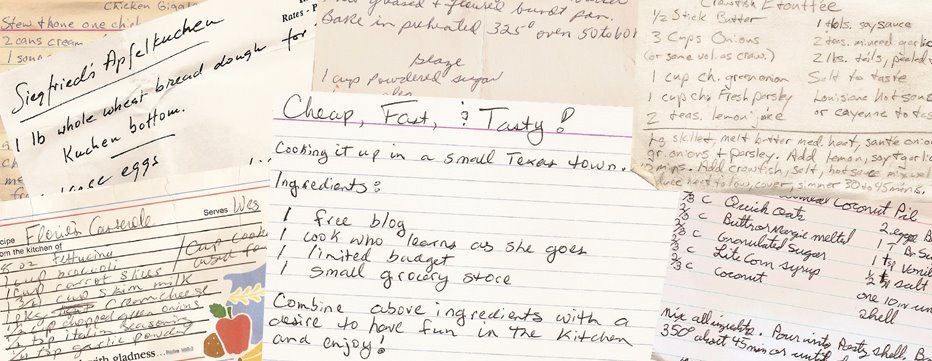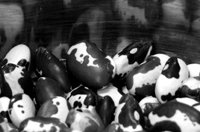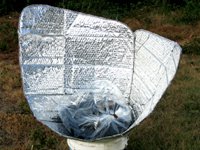I must admit defeat. My sister-in-law's nine year old beans could not be revived. Two nights of soaking and 9 hours of cooking and they still won't soften. Edible? Yes, I suppose. And they look normal enough. But tasty? No, not so much. They taste undercooked and almost raw and the pot liquor hasn't thickened the tiniest bit. This is not at all normal for beans. Two nights of soaking with frequent water changes as well as cooking them in fresh water did remove the bitterness that the first batch had. But they are just too old and won't absorb the water and soften. I tried! And I'm grateful for the gift of the food (the beans, all two cases of them, were given to us by my sister in law) even if I can't get the beans to cook!
Hubby says I am giving up too soon and that I should try the pressure cooker. I told him to go right ahead.
Here's my recipe for Yester Day Beans (a.k.a. recently purchased pinto beans):
Pinto Beans Recipe
2 lbs. beans soaked overnight--be sure and pick through your dried beans first to remove any dirt clods and mutant beans then give them a bit of a rinse before adding 12 cups of water for the soak. Next day, do not pour out the water. Cook your beans in the water they've soaked in for more flavor. Some people believe you pour out some of the gas producing sugars from the beans if you pour out the water. I can't tell a difference. Depending on how much water they've absorbed while soaking, you may have to add more water to cook them in. I like plenty of bean juice, myself. My rule of thumb is, at least 2 inches of water covering the beans. This usually means, in my bean pot, three more cups of water. But I like a lot of bean juice. If you follow the directions on the bag for how much water to how much beans--you'll do just fine. The general rule of thumb is 1 lb. of beans that have been soaked over night cooked in six cups of water. Another general rule of thumb is to throw in a ham hock when cooking the beans, I just prefer to add lots of seasonings instead of fat and meat.
Hubby says I am giving up too soon and that I should try the pressure cooker. I told him to go right ahead.
Here's my recipe for Yester Day Beans (a.k.a. recently purchased pinto beans):
Pinto Beans Recipe
2 lbs. beans soaked overnight--be sure and pick through your dried beans first to remove any dirt clods and mutant beans then give them a bit of a rinse before adding 12 cups of water for the soak. Next day, do not pour out the water. Cook your beans in the water they've soaked in for more flavor. Some people believe you pour out some of the gas producing sugars from the beans if you pour out the water. I can't tell a difference. Depending on how much water they've absorbed while soaking, you may have to add more water to cook them in. I like plenty of bean juice, myself. My rule of thumb is, at least 2 inches of water covering the beans. This usually means, in my bean pot, three more cups of water. But I like a lot of bean juice. If you follow the directions on the bag for how much water to how much beans--you'll do just fine. The general rule of thumb is 1 lb. of beans that have been soaked over night cooked in six cups of water. Another general rule of thumb is to throw in a ham hock when cooking the beans, I just prefer to add lots of seasonings instead of fat and meat.
1 whole onion, halved, and peeled (I don't like pieces of onion in my beans, in this way, it's easy to fish out the onion when the beans are done).
5 juniper berries--optional. I keep them frozen--they're just plain Texas juniper berries picked off the juniper trees that grow a few miles north of us--I set them in a few tablespoons of water to defrost them then squish them over the bean pot to get the hard seed out. Our juniper berries taste like cedar, if you can imagine chewing on cedar sprigs. Sounds like an odd thing to add to beans, but it does add a really nice flavor.
5 large cloves of garlic peeled and coarsely chopped
1 TBS salt (to start with)
2 dried Carribean Red or Scotch Bonnet peppers w/seeds (hubby grows them, I dry them and store them for year round use). This makes for some seriously spicy beans and most people find it too hot. A quarter of this amount would make most people quite happy and still be plenty warm for the lover of all things hot. You could throw in jalapeño or serrano peppers instead, by the way.
More herbs to be added later.
Bring to a boil then lower to a simmer and cover. 1. 5 to 2 hours into cooking they should be nearly done, at this point I add 1 TBS Mexican oregano (comes in bags here),
2 - 3 TBS cumin (I love cumin and prefer to use the higher amount) and fresh, chopped cilantro to taste. I leave the cover off, mostly so the house gets completely filled with the smell. This is a good point to add more salt if you need to, for my tastes that means one more tablespoon. In another 30 minutes or so the beans should be done and the herbs you've added should have infused your pot liquor. Beans, depending on where they came from and how old they are will cook faster or slower. You just have to taste test them periodically to determine when they are done.
Beans are done when they are soft and creamy. The longer you cook them past this point, the more they fall apart. Some people don't mind this. But I like my beans to stay whole. My pot liquor usually comes out thinner than I'd like--but still plenty tasty! Using less water will result in a thicker pot liquor. Or you can cheat and puree some of your beans and put them back in the pot--I never do this. You could also add a thickening agent if you liked, I never do this either. I prefer having lots of delicious bean juice to thick pot liquor. Also, once you take the beans off the stove the bean juice will continue to thicken. Well, mine doesn't thicken much but that's because I use so much water. Once my beans have been frozen and reheated, the bean juice gets thicker.
What To Do With Leftover Pinto Beans:
I freeze the extra beans in Ziplock bags and we eat them up pretty fast. The most common way we use them is to refry them and put them in burritos or we make cincos. But they're also a super convenient side dish and I love them with scrambled eggs in the morning. They reheat really well.
Refried Beans:
My beans are plenty spicy so when I refry them, I don't have to do anything special. Some people add sautéed onions, garlic and peppers and spices to their refried beans. If you've followed my recipe, you
 won't have to season yours. Heat an iron skillet to medium high with a few tablespoons of oil (or bacon grease if you like). Dump in your beans, however many you intend to refry-- juice and all, and begin mashing. Just about any masher will do. My masher is a dinky plastic version of the masher to the left here. Your masher doesn't have to be fancy. Mash and mash and scrape the pan as needed until the beans are the consistency you'd like. If you want a fat free version (the beans
won't have to season yours. Heat an iron skillet to medium high with a few tablespoons of oil (or bacon grease if you like). Dump in your beans, however many you intend to refry-- juice and all, and begin mashing. Just about any masher will do. My masher is a dinky plastic version of the masher to the left here. Your masher doesn't have to be fancy. Mash and mash and scrape the pan as needed until the beans are the consistency you'd like. If you want a fat free version (the beans
 have no added fat at all if you have followed my recipe) then just use an electric stick mixer or electric hand mixer to puree them. Simmer or heat in a non-stick skillet, if needed, until you've cooked off enough of the liquid to get them to your preferred consistency.
have no added fat at all if you have followed my recipe) then just use an electric stick mixer or electric hand mixer to puree them. Simmer or heat in a non-stick skillet, if needed, until you've cooked off enough of the liquid to get them to your preferred consistency.











No comments:
Post a Comment